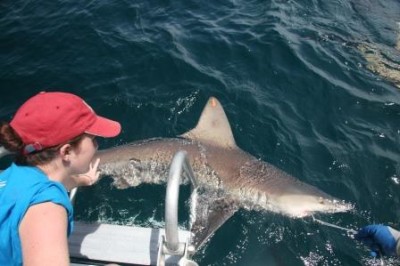
Today we drove up to Fort Lauderdale to go shark tagging with the Guy Harvey Research Institute. Before being able to actually tag these sharks we first have the be able to catch them. To be able to catch them first we put bait on a hook that is attached to a line, we then dropped a fifty-pound weight into the water that was connected to a buoy. We did this ten different in different locations and then let them sit for around one to two hours. Now is when we get to see if we caught any sharks!!
The tags
we used today were called dart tags. They are one of the cheaper types of tags
and are usually have a distinct color along with contact information of the
people that tagged the sharks, in case they are found by others. To use
these tags, we first used a leather puncher to punch a hole in the sharks’
dorsal fin. After there is a hole in the dorsal fin is when we actually put the
tag on the shark. We used the tool below to put the tag on the shark and
then made sure we wrote down the number on this shark. The good thing
about these tags is that they do not harm the shark and they do not affect
their swimming in any way.
There are also acoustic tags which produce different sounds that
can be heard with an underwater microphone, which are called hydrophones. The
sound signals that are produced are a specific sound to each of the tags. There is also passive acoustic monitoring
that are the same as acoustic tags except they are used for long term
studies.

Another type of tag is called the data logger which stores
all of their data onboard but has to be recovered from the animal to get all of
the data. These tags have long lasting
battery lives and some are even solar powered.
The problem with these tags is that they could potentially get lost and
not be recovered, so you would lose all of these data. There are also other tags that are satellite
tags that do not have to be retrieved to receive some of the data, but if the
tag is received, they will be able to download all of the data.
If you want to learn more about these different types of tags…
https://www.finsunited.co.nz/bite-blog/types-of-tags
If you want to visit the Guy Harvey Research Institute and
possibly catch and tag some sharks of your own… https://nsunews.nova.edu/s-fl-visitors-to-get-experience-of-a-lifetime-shark-tagging-with-renowned-nsu-researchers/


No comments:
Post a Comment
Note: Only a member of this blog may post a comment.